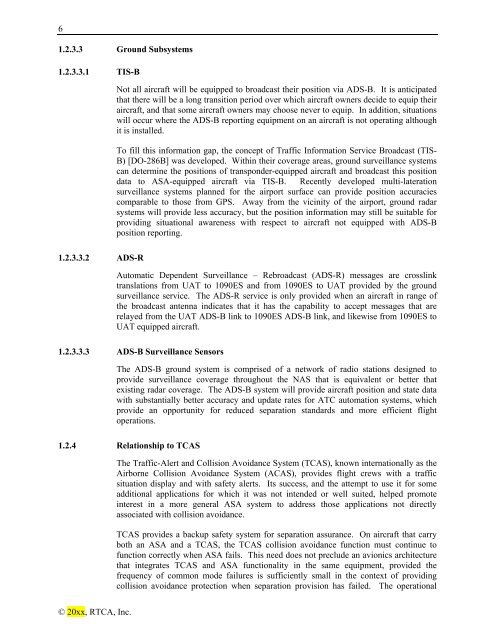Minimum Aviation System Performance Standards for Aircraft ...
Minimum Aviation System Performance Standards for Aircraft ...
Minimum Aviation System Performance Standards for Aircraft ...
Create successful ePaper yourself
Turn your PDF publications into a flip-book with our unique Google optimized e-Paper software.
6<br />
1.2.3.3 Ground Subsystems<br />
1.2.3.3.1 TIS-B<br />
1.2.3.3.2 ADS-R<br />
Not all aircraft will be equipped to broadcast their position via ADS-B. It is anticipated<br />
that there will be a long transition period over which aircraft owners decide to equip their<br />
aircraft, and that some aircraft owners may choose never to equip. In addition, situations<br />
will occur where the ADS-B reporting equipment on an aircraft is not operating although<br />
it is installed.<br />
To fill this in<strong>for</strong>mation gap, the concept of Traffic In<strong>for</strong>mation Service Broadcast (TIS-<br />
B) [DO-286B] was developed. Within their coverage areas, ground surveillance systems<br />
can determine the positions of transponder-equipped aircraft and broadcast this position<br />
data to ASA-equipped aircraft via TIS-B. Recently developed multi-lateration<br />
surveillance systems planned <strong>for</strong> the airport surface can provide position accuracies<br />
comparable to those from GPS. Away from the vicinity of the airport, ground radar<br />
systems will provide less accuracy, but the position in<strong>for</strong>mation may still be suitable <strong>for</strong><br />
providing situational awareness with respect to aircraft not equipped with ADS-B<br />
position reporting.<br />
Automatic Dependent Surveillance – Rebroadcast (ADS-R) messages are crosslink<br />
translations from UAT to 1090ES and from 1090ES to UAT provided by the ground<br />
surveillance service. The ADS-R service is only provided when an aircraft in range of<br />
the broadcast antenna indicates that it has the capability to accept messages that are<br />
relayed from the UAT ADS-B link to 1090ES ADS-B link, and likewise from 1090ES to<br />
UAT equipped aircraft.<br />
1.2.3.3.3 ADS-B Surveillance Sensors<br />
The ADS-B ground system is comprised of a network of radio stations designed to<br />
provide surveillance coverage throughout the NAS that is equivalent or better that<br />
existing radar coverage. The ADS-B system will provide aircraft position and state data<br />
with substantially better accuracy and update rates <strong>for</strong> ATC automation systems, which<br />
provide an opportunity <strong>for</strong> reduced separation standards and more efficient flight<br />
operations.<br />
1.2.4 Relationship to TCAS<br />
© 20xx, RTCA, Inc.<br />
The Traffic-Alert and Collision Avoidance <strong>System</strong> (TCAS), known internationally as the<br />
Airborne Collision Avoidance <strong>System</strong> (ACAS), provides flight crews with a traffic<br />
situation display and with safety alerts. Its success, and the attempt to use it <strong>for</strong> some<br />
additional applications <strong>for</strong> which it was not intended or well suited, helped promote<br />
interest in a more general ASA system to address those applications not directly<br />
associated with collision avoidance.<br />
TCAS provides a backup safety system <strong>for</strong> separation assurance. On aircraft that carry<br />
both an ASA and a TCAS, the TCAS collision avoidance function must continue to<br />
function correctly when ASA fails. This need does not preclude an avionics architecture<br />
that integrates TCAS and ASA functionality in the same equipment, provided the<br />
frequency of common mode failures is sufficiently small in the context of providing<br />
collision avoidance protection when separation provision has failed. The operational

















